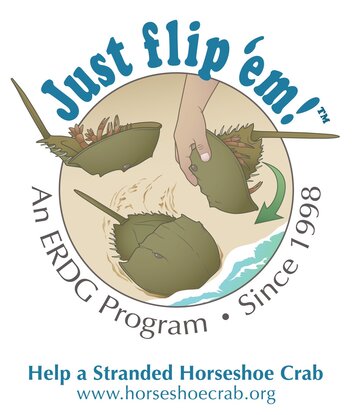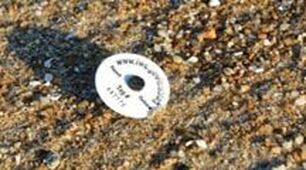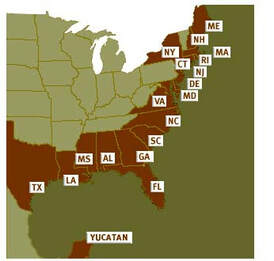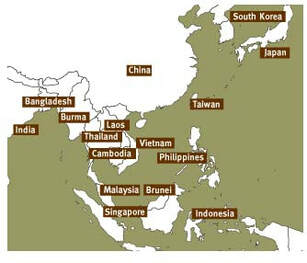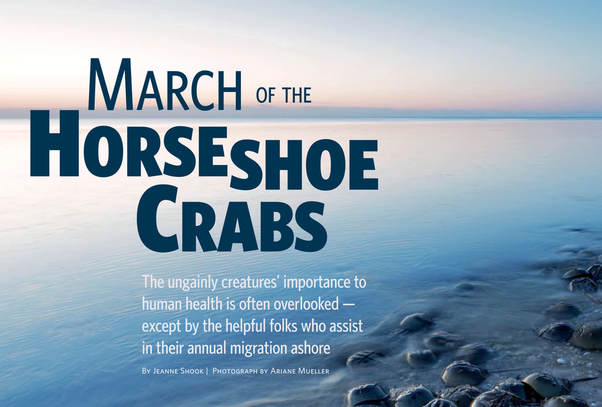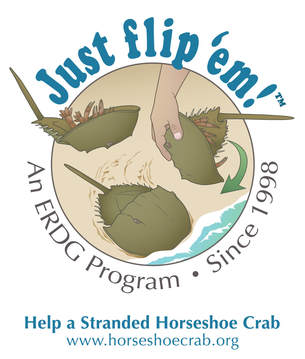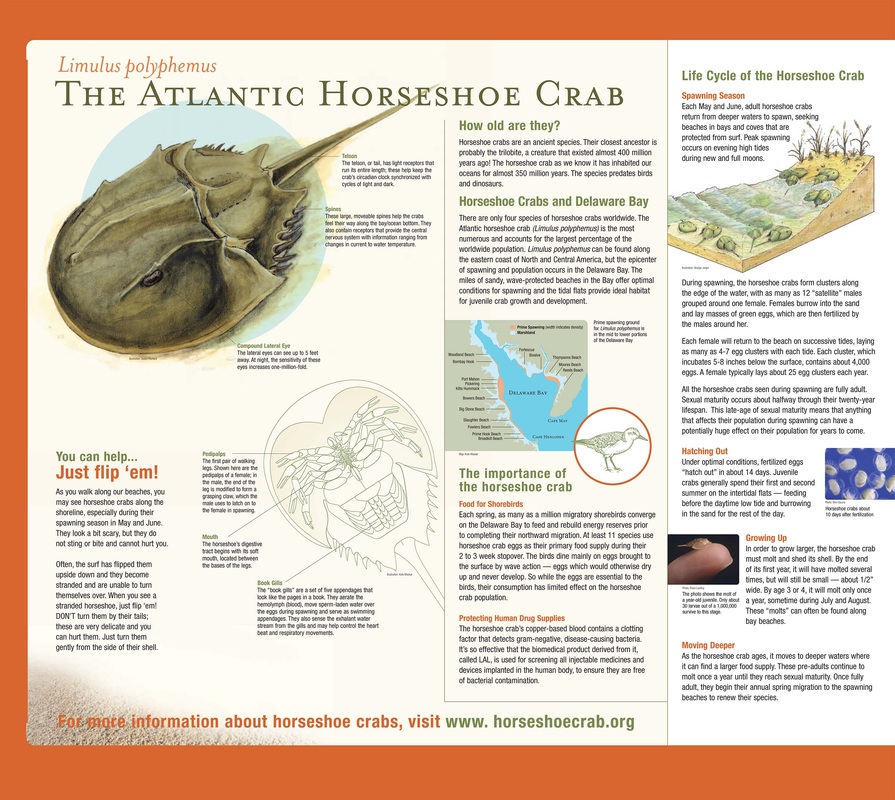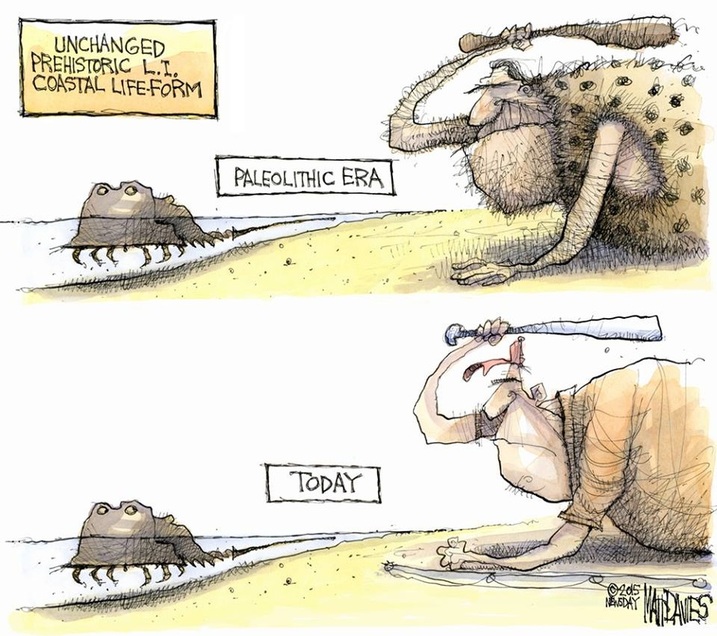"Downe's Own Ancient Mariners" ~ Beach by the Bay - Fortescue, NJ
Downe's Own Ancient Mariner.
Click on the logo above to go to ERDG's website!
To rescue Horseshoe Crabs that are on their backs gently flip them over
by holding the edge of their shell. Never use their tails! They can't pinch or bite you.
We thank you for helping our ancient friends so they are able to return next year.
To rescue Horseshoe Crabs that are on their backs gently flip them over
by holding the edge of their shell. Never use their tails! They can't pinch or bite you.
We thank you for helping our ancient friends so they are able to return next year.
Horseshoe Crab Tagging Program is Useful and Fun!
Cape Gazette - Chris Flood December 29, 2023
Story Location: 3R’s Beach, Bethany Beach, DE 19930
One of the benefits of covering an area with beaches is that every now and then, when I’ve got a few moments in between assignments, I get to walk on one and get paid for it (don’t tell Gazette owner Chris Rausch). I enjoy getting out there because I never know what I’m going to find – most of the time it’s nothing, but sometimes it’s sea glass or a buoy or something even more random.
That’s what happened the other day while I was down at 3R’s Beach just south of the Indian River Inlet. I came across a horseshoe crab tag lying face down on top of the sand that had, presumably, been attached to one at some point in the not-too-distant past.
The tag is part of the Horseshoe Crab Cooperative Tagging Program, which began in May 1999. I recognised the small, white disc as a crab tag immediately because it’s the second I’ve found. A few years ago, after a winter storm, the family and I went out to The Point in Cape Henlopen State Park where we found one that was still attached to the crab.
The tag has a website on it – fws.gov/crab tag – and a tag number that scientists and biologists are using to collect data that will be used to inform management decisions about harvest rates.
“Coast-wide management of horseshoe crabs is essential to maintain healthy populations to benefit shorebirds, the biomedical industry and the commercial fishing industry,” says the description of the program.
The website also lists Meghan Walker, a fish biologist based out of Annapolis, Md., as the person who is overseeing the program. I reached out to her, and she gave some basic information on the program.
There has been a total of 414,071 tags released, with 52,885 unique crab recaptures, said Walker. The total number of recaptures is 70,607, but that includes multiple reports of the same crab seen on a beach, she said. What’s fun about the program, and something my kids still enjoy, is that a person receives a small pewter pin of a horseshoe crab and the history of that crab if they participate in the ongoing survey. All someone needs to do is provide a mailing address. I’m looking forward to getting mine.
Cape Gazette - Chris Flood December 29, 2023
Story Location: 3R’s Beach, Bethany Beach, DE 19930
One of the benefits of covering an area with beaches is that every now and then, when I’ve got a few moments in between assignments, I get to walk on one and get paid for it (don’t tell Gazette owner Chris Rausch). I enjoy getting out there because I never know what I’m going to find – most of the time it’s nothing, but sometimes it’s sea glass or a buoy or something even more random.
That’s what happened the other day while I was down at 3R’s Beach just south of the Indian River Inlet. I came across a horseshoe crab tag lying face down on top of the sand that had, presumably, been attached to one at some point in the not-too-distant past.
The tag is part of the Horseshoe Crab Cooperative Tagging Program, which began in May 1999. I recognised the small, white disc as a crab tag immediately because it’s the second I’ve found. A few years ago, after a winter storm, the family and I went out to The Point in Cape Henlopen State Park where we found one that was still attached to the crab.
The tag has a website on it – fws.gov/crab tag – and a tag number that scientists and biologists are using to collect data that will be used to inform management decisions about harvest rates.
“Coast-wide management of horseshoe crabs is essential to maintain healthy populations to benefit shorebirds, the biomedical industry and the commercial fishing industry,” says the description of the program.
The website also lists Meghan Walker, a fish biologist based out of Annapolis, Md., as the person who is overseeing the program. I reached out to her, and she gave some basic information on the program.
There has been a total of 414,071 tags released, with 52,885 unique crab recaptures, said Walker. The total number of recaptures is 70,607, but that includes multiple reports of the same crab seen on a beach, she said. What’s fun about the program, and something my kids still enjoy, is that a person receives a small pewter pin of a horseshoe crab and the history of that crab if they participate in the ongoing survey. All someone needs to do is provide a mailing address. I’m looking forward to getting mine.
Green Eggs and Sand In-Person Workshop - June 3 & 4, 2023
During the full and new moon events in May and June, thousands of horseshoe crabs come ashore to spawn, primarily in Delaware Bay.
It is also during this time when migrating shorebirds descend upon the beaches to rest and feed on the horseshoe crab eggs before continuing onto their breeding grounds. This interaction between horseshoe crabs, shorebirds, and humans is what lays the groundwork for the Green Eggs & Sand (GE&S) workshop.
The GE&S workshop is a two-day workshop focused on understanding the issues, the science, and the management
of the horseshoe crab/shorebird controversy. Workshop participants learn from top researchers and natural
managers in the field, as well as get to participate in a horseshoe crab count.
Educators and natural resource managers from Delaware, Maryland, and New Jersey developed the curriculum, and designed it for use with middle and high school students. It is broken down into four modules that introduce students to the lives of horseshoe crabs, their extraordinary history, ecological niche, interrelationships with other species, and the challenges of managing horseshoe crabs.
At the end of the workshop, participants take home the activity-rich GE&S curriculum package and video that have been correlated to the national-learning standards in science, social studies, math and language arts.
Registration Fee: $50.00
.
For further information please contact Karen Byrne at 609-748-4347 or via e-mail at [email protected].
Glen Gauvry, (ERDG) One of 51 Nominees for
World's Leading Animal Conservation Award
Glenn Gauvry (Ecological Research & Development Group, ERDG, USA) – Engages citizens to participate in horseshoe crab conservation. Gauvry is responsible for creating the Just flip ‘em! ™ public awareness campaign to encourage individuals to help
rescue stranded horseshoe crabs. He is the founder of the Ecological Research & Development Group focused on the
conservation of the world’s four horseshoe crab species.
Article Below
INTERNATIONAL WILDLIFE CONSERVATIONISTS CONTEND FOR TOP HONOR AND $250,000 PRIZE
Nominees for World's Leading Animal Conservation Award - October 18, 2022
Officials from the Indianapolis Prize announced 51 global leaders in the field of conservation as Nominees for the
2023 Indianapolis Prize, the world’s leading award for animal conservation. The 2023 Indianapolis Prize marks
nearly two decades of celebratingwildlife’s greatest champions.
The Indianapolis Prize elevates a message of hope for our planet and highlights the stories of the dedicated people
whose work not only saves species but ensures a sustainable future for generations to come.
“The 2023 Prize Nominees represent the most accomplished wildlife conservationists dedicated to protecting and
preserving animal species,” said Rob Shumaker, president and CEO of the Indianapolis Zoo. “It is an honor to highlight
their incredible work through the Indianapolis Prize.”
Nominees hail from countries across the globe with these individuals representing a diverse range of iconic
and elusive species from primates, reptiles and birds and many more. The Winner of the Indianapolis Prize
receives $250,000 while the five Finalists each receive $50,000.
Selecting the Finalists and Winner of the Indianapolis Prize is a two-step judging structure undertaken by the
Prize Nominating Committee and Jury comprised of internationally renowned conservationists and local Indianapolis
representatives, who select six Finalists and determine a Winner, respectively. The Finalists and Winner will be honored at the Indianapolis Prize Gala presented by Cummins Inc. on September 30, 2023.
World's Leading Animal Conservation Award
Glenn Gauvry (Ecological Research & Development Group, ERDG, USA) – Engages citizens to participate in horseshoe crab conservation. Gauvry is responsible for creating the Just flip ‘em! ™ public awareness campaign to encourage individuals to help
rescue stranded horseshoe crabs. He is the founder of the Ecological Research & Development Group focused on the
conservation of the world’s four horseshoe crab species.
Article Below
INTERNATIONAL WILDLIFE CONSERVATIONISTS CONTEND FOR TOP HONOR AND $250,000 PRIZE
Nominees for World's Leading Animal Conservation Award - October 18, 2022
Officials from the Indianapolis Prize announced 51 global leaders in the field of conservation as Nominees for the
2023 Indianapolis Prize, the world’s leading award for animal conservation. The 2023 Indianapolis Prize marks
nearly two decades of celebratingwildlife’s greatest champions.
The Indianapolis Prize elevates a message of hope for our planet and highlights the stories of the dedicated people
whose work not only saves species but ensures a sustainable future for generations to come.
“The 2023 Prize Nominees represent the most accomplished wildlife conservationists dedicated to protecting and
preserving animal species,” said Rob Shumaker, president and CEO of the Indianapolis Zoo. “It is an honor to highlight
their incredible work through the Indianapolis Prize.”
Nominees hail from countries across the globe with these individuals representing a diverse range of iconic
and elusive species from primates, reptiles and birds and many more. The Winner of the Indianapolis Prize
receives $250,000 while the five Finalists each receive $50,000.
Selecting the Finalists and Winner of the Indianapolis Prize is a two-step judging structure undertaken by the
Prize Nominating Committee and Jury comprised of internationally renowned conservationists and local Indianapolis
representatives, who select six Finalists and determine a Winner, respectively. The Finalists and Winner will be honored at the Indianapolis Prize Gala presented by Cummins Inc. on September 30, 2023.
Horseshoe Crabs in the Americas - 2/21/2021
Why Does SC Lab Bleed Horseshoe Crabs for Vaccine Testing?
South Carolina: Charles River, the only company permitted to purchase the animals in South Carolina, is after their blood. Copper-based and colored light blue, the fluid that runs through their hard bodies is exceptionally good at detecting a bacterial toxin that can cause organ failure or death in humans. For almost 30 years in a facility in Charleston, Charles River has bled the horseshoe crabs, then sold a test for contaminants using the blue blood called LAL, named after the species that lives along the Atlantic, Limulus polyphemus.
The Atlantic Horseshoe Crab
Report a Sighting.
Horseshoe Crab Sightings Click are shown on the maps below.
Go to www.horseshoecrab.org to report a sighting and utilize the interactive site map
to see locations in each state or country where horseshoe crabs can be seen.
If you have seen horseshoe crabs in a location not yet listed, please let them know!
Horseshoe Crab Sightings Click are shown on the maps below.
Go to www.horseshoecrab.org to report a sighting and utilize the interactive site map
to see locations in each state or country where horseshoe crabs can be seen.
If you have seen horseshoe crabs in a location not yet listed, please let them know!
